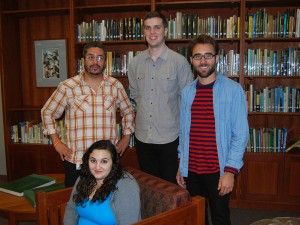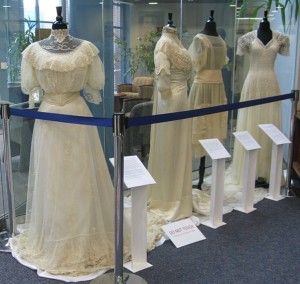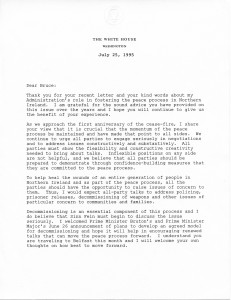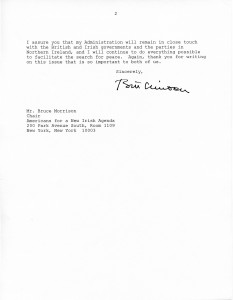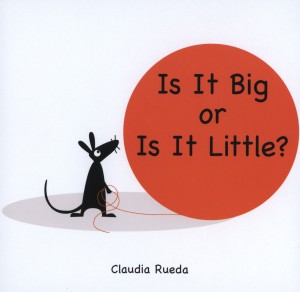
 Congratulations to Claudia Rueda, Billie M. Levy Travel Grant recipient in 2009, for the new English translation of her 2011 book “Todos es relativos.” This one is “Is it Big or Is it Little?” and is published by Eerdmans Books for Young Readers. This is a charming book for the youngest readers which compares concepts such as deep and shallow, long and short, and beginning and end. Felicitaciones, Claudia!
Congratulations to Claudia Rueda, Billie M. Levy Travel Grant recipient in 2009, for the new English translation of her 2011 book “Todos es relativos.” This one is “Is it Big or Is it Little?” and is published by Eerdmans Books for Young Readers. This is a charming book for the youngest readers which compares concepts such as deep and shallow, long and short, and beginning and end. Felicitaciones, Claudia!
Monthly Archives: June 2013
Summer 2013 Interns
Each summer Archives & Special Collections offers internships to graduate students from a broad spectrum of academic backgrounds. Interns work with collections preserved by the Dodd Research Center and learn the intricacies of preparing collections for future use by researchers. Archives & Special Collections benefits from the focused attention of these young scholars who work to enhance access to the collections we steward. This summer we are pleased to have five students working on a variety of projects. Pictured below are (seated) Arielle Rubins, (standing, l-r) Jorge Santos, Andrew Maloney and Jeffrey Egan. Not pictured is Jessica Strom.
Arielle (Psychology) is working on the development of a comprehensive finding aid for the University Photograph Collection.
Jorge (English) is extracting information from a database describing
materials in the Ed Young Papers in preparation for
the publication of the first finding aid available for the Young Papers.
Andrew (Library Science) is involved in the research and preparation of materials for a publication focused on the work of children’s author and illustrator, Tomie dePaola.
Jeff (History) is processing a portion of the papers of Congressman Bruce Morrison and updating the associated finding aid for the papers.
Jessica (History) has returned this summer to continue her work with a rare collection of broadsides from the period of the Italian Risorgimento. She is selecting broadsides from 1848 that will be digitized and made available online in September 2013.
Exhibit opening: PRINCESS FOR A DAY
Please join us for the formal opening of
PRINCESS FOR A DAY: WEDDING GOWNS FROM 1860- 1960
June 27, 2013 from 4 -6 pm in the Thomas J. Dodd Research Center.
The gowns are on display in the John McDonald Reading Room
from May 5th through August 31st, 2013.
Queen Victoria married Prince Albert in 1840 and was photographed in her white wedding gown of heavy silk satin woven at Spitalfields in East London. Her portrait was spread around the world and this exhibition shows the results of those wedding fashions traveling to America. Wedding gowns from UCONN’s Historical Costume and Textile Collection give a look at a time in American history when the concept of weddings changed, following in the steps of the European Royals, hoping to live happily ever after.
RSVP for opening reception to: princessforadayuconn@gmail.com
The Railroad of “Bankruptcy, Litigation, Fraud and Failure”
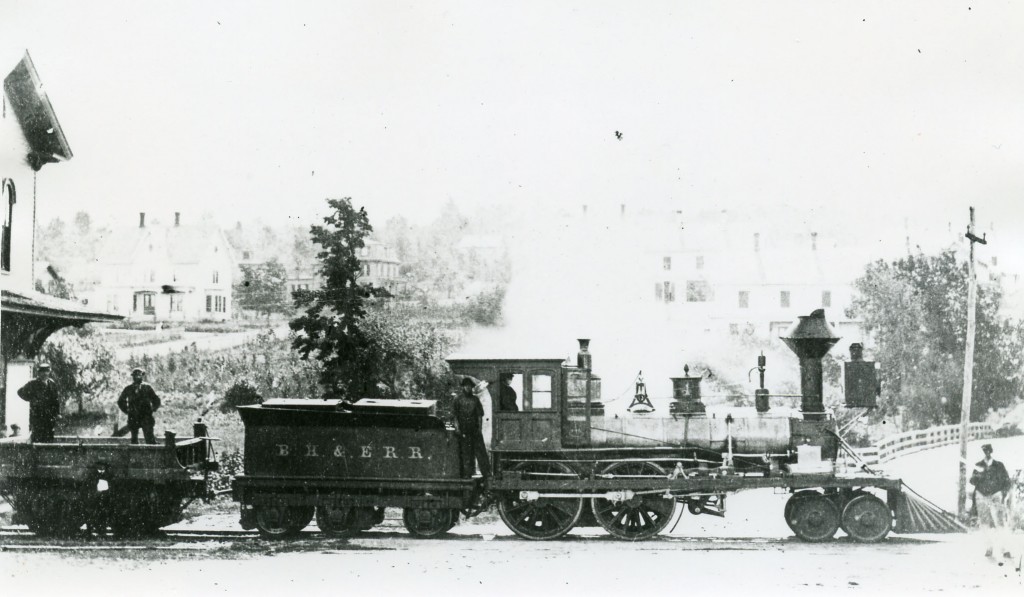
The “Hookset,” built in 1842 at the Hinkley & Drury Shops for the Concord Railroad. Was Locomotive #1 of the Boston, Hartford & Erie Railroad in 1863, then the New York & New England Railroad’s Locomotive #1 in 1871. From the Frances D. Donovan Papers, Archives & Special Collections, University of Connecticut Libraries.
One hundred and fifty years ago, in June 1863, the Boston, Hartford & Erie Railroad was incorporated with the goal of forming a gateway to western markets for New England goods and of bringing coal from Pennsylvania into New England by way of Newburgh, New York, to Waterbury, Connecticut, and beyond. Its lofty goal disintegrated when it came under the control of “as ribald a bunch of crooks as railroad history has ever produced,” wrote D.W. McLaughlin in his article “Poughkeepsie Gateway,” for the October 1968 issue of the Bulletin of the Railway & Locomotive Historical Society. The railroad ran into a myriad of troubles, including the realization that building an east-west route across Connecticut would involve navigating the state’s ridge lines, the problem of aligning with the non-standard gauge of track on the Erie Railroad (the western line it would hook up with once the railroad cars crossed the Hudson River), and the lack of a bridge for which to travel over the river. That apparently did not stop the railroad’s promoters from selling stock in the line, which they proceeded to mercilessly raid and pillage. The legislature of the state of Massachusetts was persuaded to give $3,000,000 in grants, odd in that the bulk of the railroad didn’t actually travel in that state, as it went into Connecticut. By the time the graft caught up with all the players, in 1870, the railroad was in bankruptcy with a mere $10.00 left in its accounts, Massachusetts was out all of the money it invested, and very little actual railroad track was ever laid. The remaining assets were transferred to the receivers of the New York & New England Railroad, who rerouted the railroad line from New York City to Boston and eventually became part of the New Haven Railroad system.
When Irish Eyes are Reading
Jeffrey Egan is a graduate summer intern in Archives & Special Collections working on the papers of Congressman Bruce Morrison. Jeff is a PhD. Student in US History at the University of Connecticut. His dissertation will examine the social and environmental history of the creation of the Quabbin Reservoir in Massachusetts during the 1920s and 1930s.
This summer, as Congress debates a bill designed to overhaul the US immigration system, one former representative from the state of Connecticut will have his ear to the ground. Bruce A. Morrison, a Democrat who served as a Representative for Connecticut’s Third District from 1983 to 1991, is an ardent supporter of immigration reform. During his tenure in congress, he was appointed Chairman of the House Subcommittee on Immigration and supported the passage of the Immigration Act of 1990, the last substantial immigration bill passed by the US legislature. Perhaps his most celebrated addition to the legislation, especially in the estimation of Irish-Americans, was the “Morrison Visa” program, which increased the number of visas granted to various nationalities including 48,000 for Irish immigrants. Morrison later served as a member of the US Commission on Immigration Reform, which produced a report in 1997 recommending further action on the issue.
Beyond documents relating to immigration reform, the Bruce A. Morrison papers include materials from his 1990 campaign for the Connecticut governorship, his work as chair of the Federal Housing Finance Board, and his role in the Irish peace negotiations during the 1990s. A former Yale Law School classmate of Bill Clinton, Morrison also devoted his political energies to rallying Irish-American support for the Clinton/Gore campaigns in 1992 and 1996.
As a graduate student intern at the Archives & Special Collections of the Thomas J. Dodd Center, my task is to prepare Mr. Morrison’s papers for the researchers of the future. Just a few short weeks into the summer internship, my project has opened my eyes to the vitally important, and challenging, work of archival management that makes possible my studies as a graduate student in the history department. Working behind the scenes, an archivist must strike a delicate balance between enhancing ease of access to a person’s papers and retaining the organizational integrity of the documents, which can give researchers some sense of the life and worldview of the historical actor. This new understanding of how documents move from private to public hands, and the nuanced work of the archivist, will inform my own research this fall when I hang up my archival gloves and return to the reading room.
Punk Rock in Connecticut
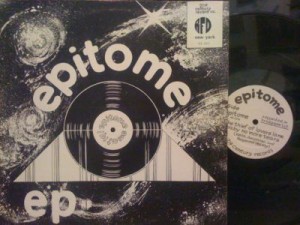 A recent acquisition to the Alternative Press Collection is one of the first record albums to be printed in Connecticut of the musical genre popularly known as punk rock. Printed in 1978 by 21st Century Records, the band Epitome released their first album, a self titled vinyl 12″, Epitome ep, containing three tracks: The Thief of Lover’s Lane, Baby No More Tears, and Transistor Sister. Epitome formed in 1977 in Stratford, CT. Playing venues from Bridgeport’s own The Snakepit, The Shandy Gaff in Milford to New York City’s famous C.B.G.B.’s and Max’s Kansas City. The youth culture which formed out of the punk scene represents a politicized anti-establishment ethos and aesthetic that challenged previous youth movements from the late 1960s student based revolt.
A recent acquisition to the Alternative Press Collection is one of the first record albums to be printed in Connecticut of the musical genre popularly known as punk rock. Printed in 1978 by 21st Century Records, the band Epitome released their first album, a self titled vinyl 12″, Epitome ep, containing three tracks: The Thief of Lover’s Lane, Baby No More Tears, and Transistor Sister. Epitome formed in 1977 in Stratford, CT. Playing venues from Bridgeport’s own The Snakepit, The Shandy Gaff in Milford to New York City’s famous C.B.G.B.’s and Max’s Kansas City. The youth culture which formed out of the punk scene represents a politicized anti-establishment ethos and aesthetic that challenged previous youth movements from the late 1960s student based revolt.
To listen to this record, please make an appointment with the Alternative Press Curator.

